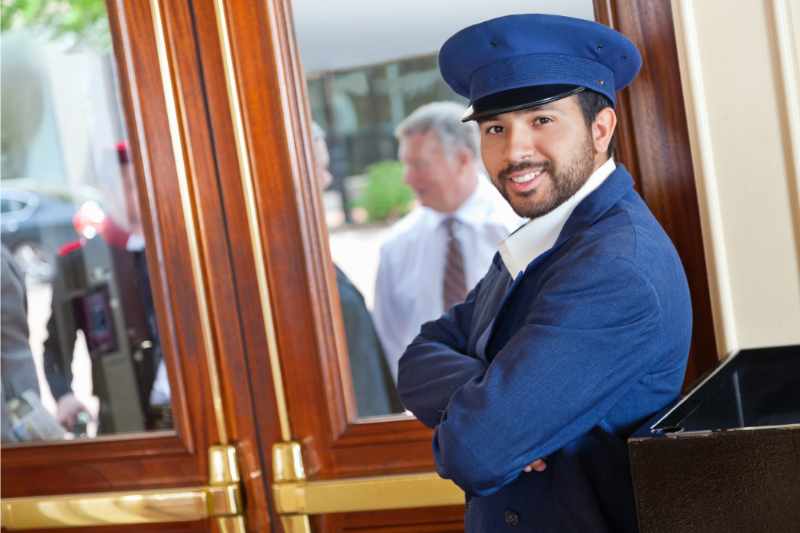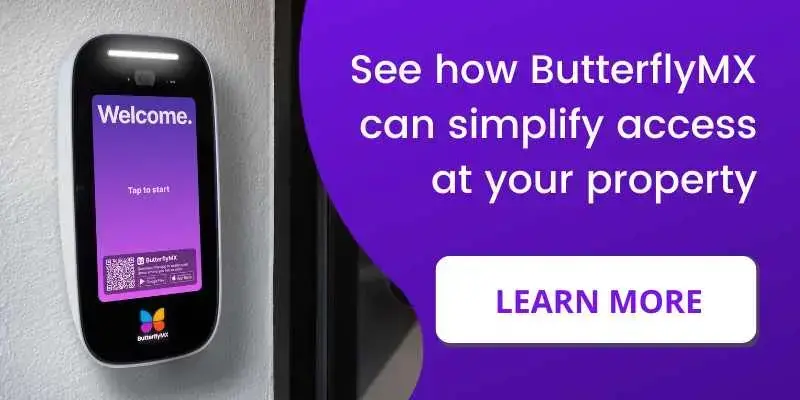Key takeaways
- A doorman handles access control and security at residential and commercial properties.
- Doorman services are technologies that complement the job duties of a doorman and make access to a property even easier.
- The different types of doorman services include Virtual Doorman, telephone entry systems, and video intercom systems.
- A video intercom system is the best doorman service (in addition to a human doorman).

Doormen are a valuable asset to any large residential property, especially in cities with high volumes of people coming and going at any given time. In addition to living and breathing doormen as staff at a property, there are now a number of different remote doorman services that you can use. With new technology comes a variety of use cases that may or may not benefit your property.
This post covers what a doorman is and the benefits they provide to a specific property. Next, we explore the different types of doorman services that are available. Finally, we explore a specific doorman service that can benefit any property.
This post covers:
What does a doorman do?
A doorman keeps a building secure by greeting and vetting visitors. At residential properties, a doorman is likely familiar with all of the residents and knows which floor they live on. Residents can give the doorman instructions to let in guests, and the doorman usually has the ability to call up to a resident to let them know that someone has arrived.
Doormen can also:
- Manage packages
- Physically hold open and close doors
- Control and call elevators
Depending on the size of a property, multiple doormen can be employed with rotating shifts. Because two out of five workers work unconventional shifts at all hours of the night, some properties employ doormen 24 hours a day.
It’s because of these caveats that technology in the form of doorman services can help improve both aspects of this job and building access for all.
What is the difference between a concierge and a doorman?
While we’ve defined what a doorman is above, a concierge is more likely to be found at a hotel. Concierges help someone navigate the surrounding areas of a property. They most commonly help find restaurants, pharmacies, and public transportation. They have also been known to provide “locals-only” advice that will help a visitor get the most out of their trip.

Why do NYC buildings have doormen?
Many NYC buildings most famously have human doormen (as opposed to digital doormen) because of the sheer number of people in the city at any given time. Doormen keep unwanted visitors out of residential and commercial properties. They also are present to reassure visitors that yes, they are, in fact, in the right building despite there being 20 similar buildings on the same street.
What are the 3 best doorman services?
There are a number of different technologies that complement doormen and property access, including cyber doormen. While all of these technologies simplify access and make residents’ and visitors’ lives easier, some are more appropriate for certain buildings than others. It’s important to understand how each doorman service works before committing to one.
Doorman service options include:
1. Video intercom system & front desk station
Doorman services such as a cloud-based video intercom system provide a high-functioning form of visitor management. Access control systems such as the ButterflyMX video intercom come with a number of intuitive features that simplify access for residents, employees, and visitors.
Additionally, when you pair our video intercom with our front desk station, you can feel confident in who enters your property.
The ButterflyMX video intercom system and front desk station:
- Provides a mobile app that allows users to open doors remotely.
- Allows remote access for visitors and package delivery carriers.
- Is easy to install.
- Features a camera for live video calls with residents and building staff.
- Takes a date- and time-stamped photo of everyone who enters the building for security purposes.
- Integrates with property management software, ensuring that access permissions are up to date as residents move in and out.
- Allows you to call residents from the station to verify the visitor’s identity before granting access.
- Offer temporary access to the property from the station.
A video intercom system paired with a front desk station is by far the best doorman service for most properties, combining the benefits of the other services as well as those of human doormen.
With that said, the ButterflyMX front desk station does not require additional hardware. Instead, you can simply use it on its own with a third-party webcam. That way, you can still verify visitors’ identities and maintain a clear log of entries.
Learn how the ButterflyMX front desk station works:
2. Virtual Doorman
Virtual Doorman is an NYC-based company in the remote doorman industry that includes front-entry hardware and an off-site call center team that mimics the function of a human doorman. The call center employs live, human operators who interact with residents and guests and control access. The operator can also see who’s requesting access since the Virtual Doorman hardware has a camera.
This tech comes with a virtual doorman app that residents use to access the building through their unique virtual doorman login.
While it shouldn’t be used as a replacement for human, in-person doormen, this technology can be used to make their job easier and manage access at off-peak hours, during the holidays, or for less-used access points.
Pros:
- Remote management is easy to use.
- Offers different plans that can fit your unique needs.
- Provides after-hours access, reducing the need for a human doorman to wait for hours on end.
Cons:
- Hardware installation can be costly.
- Lacks the same security an onsite human doorman can provide.
- The basic plan is very basic.
How much does it cost to install a virtual doorman?
Virtual Doorman costs a few thousand dollars to install, depending on your building’s infrastructure. You may also have to pay ongoing service fees.
3. Telephone entry system
A telephone entry system allows people to call a building’s front desk or remote staff members to request access into the building. Essentially, this system is a simplified version of a remote doorman that doesn’t rely on an outside call center.
Pros:
- This system may be relatively affordable.
Cons:
- There is no video component, which makes this system less secure than other doorman services.
- Telephone entry systems may need extensive wiring, which can make them expensive and difficult to install.






